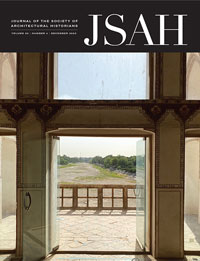Special Issue Editors: Dr. Cathelijne Nuijsink (ETH Zürich) and Prof. Dr. Tom Avermaete (ETH Zürich)
This thematic issue
engages with the methodological challenge of writing a global history
of architecture through the lens of architecture exhibitions operating
as cross-cultural ‘contact zones’. Languages and literature scholar Mary
Louise Pratt defined contact zones in the context of colonial studies
as ‘social spaces where cultures meet, clash, and grapple with each
other, often in contexts of highly asymmetrical relations of power’
(Pratt, 1991: 34). Scholars from different fields have creatively
appropriated Pratt’s concept, suggesting, for example, that looking upon
literary developments as ‘sites of struggle’ can facilitate radical
reorganisation of the canonical histories of English literature
(Bizzell, 1994). Similarly, viewing a ‘museum as contact zone’ can be
used as a way of expanding the museum’s role so that it becomes a place
where cultural biases are confronted and dialogue can occur (Clifford,
1997). Political science scholar Elizabeth Kath, commenting on the
differences between Latin American dance and music in its original form
and the forms seen overseas, argues in favour of a multidirectional and
multi-layered way of thinking about cultural contact (Kath, 2016). Kath
proposes distinguishing between the layers of transculturation, to
account for people and cultural forms moving around the world and across
national boundaries and for their coming into contact with one another.
Applied to the field of architecture, we would like to think of
contact zones as intensive sites of encounter between different
architecture cultures that result in a productive exchange of ideas;
these encounters include architectural competitions, exhibits,
conferences, biennales, summer workshops, international classrooms, and
development aid projects. Contact zones help us understand the intricate
circulation of ideas within architecture culture on a meta-theoretical
level as a productive concept to expose power dynamics and include
previously repressed perspectives. Simultaneously, an architectural
history structured around contact zones allows a bottom-up perspective
of cultural encounters in which ‘the history of diverse places becomes
connected and interdependent’ (Hunt, 2014: 57). Architecture and Culture
Vol. 12, Issue 1 (2024) explores the ability of the architecture
exhibition to act as a cross-cultural contact zone and reveals how
exhibitions function as important platforms for the confrontation,
exchange and development of architectural ideas. Looking at architecture
exhibitions through the lens of contact zones suggests that ideas are
not simply exported, imported or translated but that they move across
different cultural contexts through complex processes of
transculturation. Examining the mechanics behind architectural contact
zones, we argue, can result in a cross-cultural, multi-authored and
poly-conceptual reframing of architecture history.
With a boom in cultural institutions placing architecture ‘on
display’ in the late 1970s, research on architectural exhibitions gained
currency. In recent decades, scholars have paid attention to thematic
foci, curatorial strategies, and the performative characteristics of
exhibitions. Publications such as Exhibit A. Exhibitions That Transformed Architecture, 1948-2000 (Eeva-Liisa Pelkonen, 2018) and Place and Displacement. Exhibiting Architecture
(Arrhenius, et al., 2014) addressed how the field of architecture has
propelled curatorial approaches and how, in turn, exhibitions have
shaped the discipline of architecture. Others, including The Model as Performance (Brejzek and Wallen, 2017) and Log #20: Curating Architecture
(New York: Anyone Corporation, 2010), have scrutinised the performative
capacities of the architecture exhibition. However, these studies have
largely ignored the role that exhibitions play as sites of
cross-cultural exchange propelling the discipline of architecture. This
omission is startling, since exhibitions have long functioned as
important platforms for the confrontation, exchange and development of
architectural ideas from different cultures and geographies. The United
Nations International Exhibition of Low-Cost Housing (New Delhi, 1954)
and the German Mobile Exhibition travelling 24,000 km throughout Africa
between 1961 and 1963 are but two examples in which the confrontation
between designers, curators, audiences and exhibits from different
geographical locations resulted in a lively, transnational discussion.
In this thematic issue, we ask authors to conceptualise the
architecture exhibition not as a mere cultural event but as a productive
encounter between different architecture cultures that produces
friction and resistance as well as ‘exhilarating moments of wonder,
revelation, mutual understanding and new wisdom’ (Pratt, 1991: 39). We
particularly seek scholarly contributions from non-Western contexts that
stimulate new insights in architectural knowledge production in
‘South-South’ relations. In their analysis of a specific exhibition case
study, authors should trace how designers, curators, audiences and
exhibits from different cultures encountered one another ‘on display’,
and reveal how architectural concepts are constituted in and by their
relationships with one another. Instead of relying on individual
geniuses and their individual ideas, this issue argues for just the
opposite. Looking at the discipline of architecture through the lens of
exhibitions operating as contact zones, the issue focuses on the way in
which architectural knowledge is predominantly produced by way of the
co-presence, interaction and interlocking of people, theories and
practices.
Submission Instructions
This call is open to scholarly articles of varying lengths
(maximum 7000 words or equivalent visual content, inclusive of tables,
references and endnotes) and visual essays that offer new insights into
the architectural exhibition operating as a contact zone. Full articles
will be reviewed by the guest editors on thematic relevance, innovation
and evidence of an explorative academic level. After the initial review,
full papers will go through a rigorous double-blind peer-review
process.
Please select 'Special Issue: The Architecture Exhibition Operating
as a Cross-Cultural Contact Zone' when submitting your paper to the
online platform.
Submission deadline for full papers is 1 October 2022.


